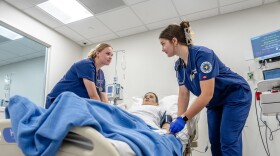Award-winning author and illustrator John Rocco is perhaps best known for his cover art on the Percy Jackson and the Olympians series and other children's books. But about 20 years ago, Rocco worked at a company called Digital Domain doing special effects for a little film called Apollo 13, which he says sparked a deeper interest in the many complexities of how we get people into space.
Today, Rocco has a new children's book called How We Got To The Moon: The People, Technology, and Daring Feats of Science Behind Humanity's Greatest Adventure. He wrote and meticulously illustrated each step of the space race and tells the stories of the 400,000 people behind this grand accomplishment.
Rocco notes that while there are lots of children's books on the Apollo missions, most focus on the astronauts and their mission — not about what led to them.
"For me, it was about the people on the ground who made the machines that actually supported this mission. And I wanted to structure it in a way where you've got some of the history as to why we were actually going to the moon but also you would slowly uncover the science behind it all," he explains.
How We Got to the Moon can be considered a science, physics, history and art book all in one. Rocco includes not only the machines that helped humans get to the moon but the scientific ideas that build upon each other.

Rocco spent years researching for this book. He says his most valuable resources weren't blueprints or diagrams — but people.
"There's a lot of things that I didn't understand. And I knew if I couldn't understand them, there's no way I could present that information to a young reader and have them understand it. So, I started reaching out to the Apollo engineers themselves," he says.
One of those engineers is JoAnn Morgan — the only woman in the Launch Control Center when Apollo 11 lifted off, where she worked as an instrumentation controller. Her career spanned more than 45 years at NASA and she held top positions, including as the first woman associate director for the Kennedy Space Center. Today, Morgan is still involved in encouraging other women to get involved in STEM.

While she calls herself "a lucky kid at the right place at the right time with an inclination," Morgan set her path at just 17 years old. She worked tirelessly to become an engineer at a time when women weren't welcome in the room. After working in the launch industry at NASA for 10 years, Apollo 11 was Morgan's first time sitting in the firing room at liftoff.
"I hope that there's girls that are going to get a chance to read this book, that they really do some serious thinking about the fact that we need women in engineering," she says. "We are all able to do everything — men, women, no matter what race — the potential is in each human being. And I think that each human being should aspire to be as great as they can at what they love doing."
While Morgan doesn't describe herself as a natural leader or even the best engineer in the room, she says her main motivation while working at NASA was seeing bad decisions being made.
"When I saw some of the bad decisions that men were making I thought, 'I wouldn't have done that.' We would go faster, we wouldn't have had an accident, we wouldn't have had something terrible happen if I had been part of the decision process," she notes.

Morgan believes the key to the future of engineering is for women to be a part of the decision-making process. She notes that less than 15% of working engineers in the U.S. today are women.
"That's a terrible statistic. It was less than 2% when I started out as a young NASA engineer. We haven't come that far," says Morgan.
Rocco hopes that young readers seeing their own faces in How We Got To The Moon can open up new possibilities and inspire future careers in STEM.
"I hope to inspire problem-solvers, and that’s why I created this book. I wanted people to look at, here’s an impossible problem — we’re going to go to the moon, and we’re gonna do it in nine years ... And it's this incredibly impossible problem and all of these people got together and they worked together and they solved each little problem at a time and they strung all those solutions together."
John Rocco, JoAnn Morgan and Ann Montgomery, the Apollo lead crew systems engineer, will hold a virtual event for Boswell Books this Friday evening.








